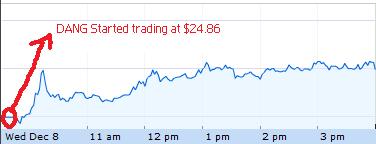I have watched both YOKU and DANG stocks in the past week, when they started trading last Wednesday. In 3 trading days, YOKU was up over 42% (at one point on Friday, YOKU touched $50 and thus was up almost 100%, I feel sad for those who bought at this price), and DANG was up over 31%.
Now what are YOKU and DANG?
YOKU is a stock for a Chinese YouTube clone, youku.com. DANG is the stock ticker for dangdang.com (yet another) Chinese company, but this one is cloning Amazon.
Now I have visited both Youku.com and DangDang.com, but seeing how I don’t understand Chinese, I just looked at the pictures there, and I wondered. At the current price, Youku.com has a market capitalization of $2.5 Billion and DangDang has a market capitalization of $600 million. Let’s do the comparison apple by apple.
Google acquired YouTube for $1.65 billion back in 2006 (just over 4 years ago), the online video arm of the company that despite being very popular, is still considered to be a liability for Google despite some people believing that it has just started making money. Now let’s compare YouTube.com to Youku.com, to see how much the latter is worth:
Youtube.com caters for the whole world, and even assuming that China is not part of that world Youtube.com (which is a false assumption), this means that Youtube’s potential audience is 5.4 billion. Assuming that Youku.com controls all of the Chinese online video market (another false assumption, but I’m trying to see what the maximum value of Youku.com is), this means that Youku.com may serve 1.3 billion people. Assuming that the American and international audience are worth the same as the Chinese audience when it comes to converting for ads, this means that Youku.com should be valued at a maximum of 1/4 the value of Youtube.com, which is about $412 million, and with 66.32 million shares, then YOKU’s realistic price is $6.21, so it is trading right now at 6 times that amount. But is this realistic price fair? I don’t think so…
See we’re assuming that YouTube was worth the $1.65 billion in the first place, but this false. Youtube.com is a website that can be easily cloned (with 1000s of clones out there, including Youku.com) and is a big hole in Google’s pockets (all that money spent on bandwidth and the maintenance of the website). I think Google’s long term aims from YouTube is the publicity and the viralness (I don’t know if that’s a word…), and hey, it’s even better if it makes some money here and there, just to cover it costs, but Google doesn’t care if YouTube is making money or not, nor do Google investors, who are confident that Google can support YouTube as well as the myriad of other money-losing products they (by “they” I mean Google) bought.
Youku.com is a completely different case:
– Youku.com is not supported by, let’s say, Baidu.com (Google’s Chinese clone). Youku.com is taking the money directly from investors, money that can be easily burned in a few years of this website’s operations, with not even a dime of income. I know that investing in stocks is a long term vision of the company, but this company will never ever make money. The Chinese market can never be compared to the American and European markets.
– If Youku.com fails, it will file for bankruptcy immediately, not a single sane financial institution will support its business model.
– China’s economy is cooling, they cannot sustain this growth forever. The US economy, on the other hand, is recovering.
– Youku.com will probably be sued by dozens of Viacoms over copyright infringement issue. Of course, Chinese websites don’t care a lot about copyright issues, but when you’re trading in the US market, you’re most likely bound by their rules. In all fairness, most probably the only content on Youku’s website will probably be real pirated movies and stupid videos.
Those who made money in the first few days should get out of this stock, fast! Those who are duped into believing that this is a great long term investment should rethink their investment strategy.
Now let’s move to DangDang.com…
As stated earlier, DangDang.com is an Amazon clone. Amazon currently has a market capitalization of about $78 billion, but with a P/E of 71 (AMZN is currently trading at $175), Amazon is a highly overvalued company. At this current valuation, it’ll take Amazon just over 70 years to repay investors with its current earnings. A much realistic P/E is 25, which values the company at $27.5 billion, a fair amount that DangDang can be compared to. Going into the same discussion above (International market size and Chinese market size), we can easily calculate that the DangDang can be worth $27.5 / 4 = $6.85 billion, making the stock price a hefty $373. But DangDang does not control the Chinese market, even Amazon has a bigger share in that market (which is something we completely ignored in our calculation, we assumed that Amazon does not even exist in China), and how big is the online Chinese book market compared to the US one anyway? Amazon.com ranks #5 in the top 100 websites in the US (according to Alexa), while Amazon.cn ranks #77, one spot above DangDang’s (which ranks at #78). This clearly means that interest in books in general is much lower in China than in the US, about 15 times lower. Now by taking the $373 we calculated before, and dividing that number over 15, we would get $24.86, which is very interestingly, the same price that DANG started trading for back on Wednesday:

DANG started trading at $24.86
So are they real? Yes, they’re both real, the websites for these 2 stocks exist, and are very prominent in China. Scam? Maybe not… Overvalued? Definitely… But DangDang.com, as a company, has a much better chance of repaying investors than Youku.com.

